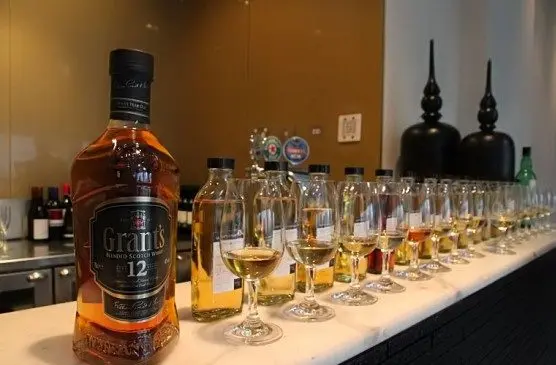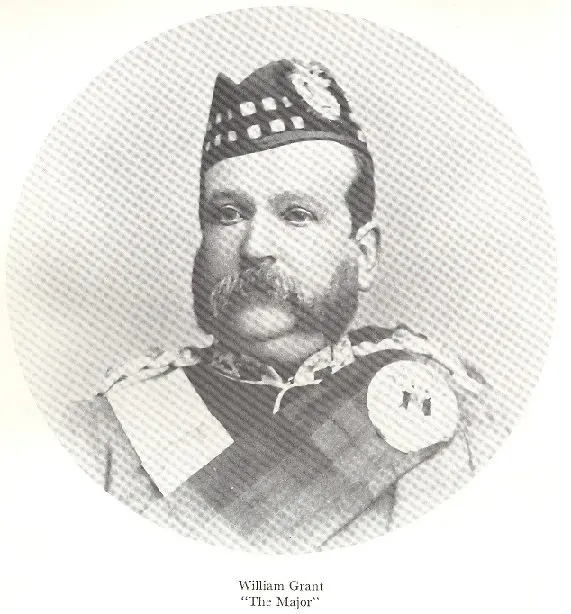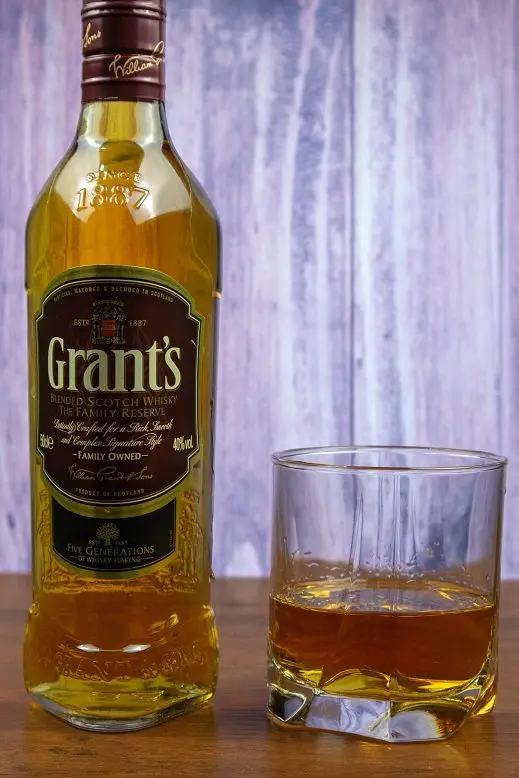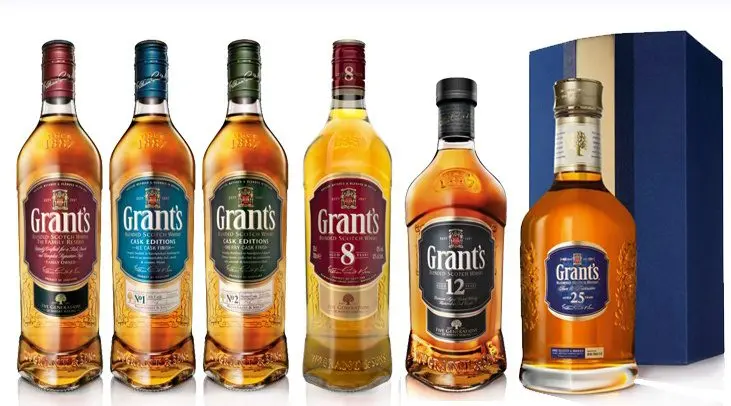Contents
Grant’s – a harmonious combination of 25 varieties of malt and grain whiskey. It is this harmony of taste, aroma and visual image that is called the reason for the success of the world-famous scotch tape. The recognizable triangular bottles of Grants contribute to the popularity of the drink.
The redesign of the bottle in 1957 was developed by the German Hans Schleger. Each facet of the cocked hat has a special meaning, embodies the fundamental principles of the company:
- fidelity to traditions;
- reverent attitude to family values;
- high level of quality.

The practical meaning of the triangular shape is even deeper than visual appeal and philosophy – bottles are convenient to store and transport, they fit compactly. Schleger came up with this form when he was looking at a honeycomb: from 6 bottles of Grant’s tightly arranged in a circle, an image of a honeycomb is obtained.
Historical information
In 1886, William Grant, a modest accountant and later manager of the obscure Mortlach distillery, decided to build his own distillery in the Glenfiddich Valley. The family was a great help to the novice businessman – his wife and 9 children worked tirelessly next to William. Whiskey appeared on Christmas Eve 1887. I must say that the first bottle of scotch saw the light only 11 years later, before that, whiskey was sold by barrels to other producers. This is a common practice, many Scottish distilleries do not have their own branded drinks, they just create excellent spirits for blending.

The son-in-law of William Grant, Charles Gordon, was the first to seriously engage in the search for domestic and foreign markets. Thanks to his efforts, by the beginning of the First World War, the products of the Grant distillery began to be supplied to the USA and Europe.
Despite the wars, Prohibition in America, various difficult circumstances and the crisis, William Grant & Sons did not stop working. The assortment expanded, capacities increased, equipment was modernized, but the company never passed into the wrong hands – this is a family business. And now the fifth generation of Grants manages the affairs.
Blended Scotch Grant’s appeared much later than single malt Glenfiddich and even blended Clan MacGregor. But in the William Grant & Sons product line, this brand is symbolic: it is named after the founder of the company.
Today, Grant’s is produced at the company’s second distillery, Girvan, which was built by the founder’s great-grandson Sandy Grant in 1963 at the Penwhapple spring with surprisingly soft water. The enterprise was built for the production of grain whiskey, which is used in blends.
Grant’s records
1979 For the first time in the UK, 1 Grant’s nine-litre cases have been sold. 000 liters is a traditional measure of the sale of alcoholic products, 000 liter seems frivolous to alcohol producers, and it is inconvenient to count bottles, since they come in different volumes.
2007 4 types of Grant’s receive the highest awards from the International Expert Jury: Grant’s Family Reserve, Grant’s 8 Years Old, Grant’s 12 Years Old, Grant’s Sherry Cask Finish.
Production features
Girvan grain whiskeys are blended by master blenders with different shades of the finest single malts. For example, from Glenfiddich peach notes appear in the composition, from Balvenie – a nutty flavor. And each master is careful to the experience of his predecessor. William Grant & Sons are proud of the fact that for all the time in the company only 6 blend masters have replaced each other, starting with William himself. The last master, Brian Kinsman, succeeded his predecessor David Stewart, who had been with the company for almost 40 years, in 2008.

For aging whiskey use different oak barrels – both new and old. The company has its own cooperage workshop for the production of two types of wood:
- white American oak (Quercus Alba), enriching the aroma of whiskey with sweet notes of vanilla;
- Spanish pedunculate oak (Quercus Robur), which gives the taste of the drink a touch of dried fruit.
During the roasting of barrels, the sugary substances of the wood are caramelized, due to which the taste, color and aroma of the ripening drink are formed. Bourbon casks are usually preferred when making Grant’s, but in the case of Grant’s Ale Cask Reserve, for example, they are aged ale. Therefore, the drink has a creamy taste with a subtle bitterness, unlike most types of Grant’s, which smell of vanilla and dried fruits.
Cocktail Recipes
Grant’s Manhattan. 50 ml of Grant’s Family Reserve, 15 ml of red vermouth and 10 ml of orange bitters (Angostura Orange bitters), XNUMX ml of cherry and sugar syrup – mix all this in a shaker and serve in a chilled tall glass with an orange slice.
Hot Toddy Grant’s. In 250 ml of boiling water, add 2 tablespoons of honey, juice of half a lemon, 50 ml of scotch tape and three buds of dried cloves. Drink hot, in small sips. This intensely warming remedy is especially useful when a cold develops. In a glass (or cup) you can add 2 lemon slices.
Grant’s Sour. 50 ml Grant’s 12 Year Old, juice of 1 lime, 2 teaspoons of sugar syrup – mix in a shaker and serve in a chilled glass with a mint leaf.
Types of whiskey Grants
- Grant’s Family Reserve. Sunny golden Scotch matured in bourbon vats, has a multi-faceted flavor with a slight malic acidity and hints of banana and malt. The aroma is delicate, clean with fruity notes. Fortress 40%. The drink received the title of “Genius Glass” from an expert jury at the Whiskey Bible exhibition in 2007.
- Grant’s 8 Years Old. Whiskey light golden color with a mild apple flavor, which shows hints of vanilla and malt, and a sweet spicy aftertaste. The aroma is spicy, slightly harsh with notes of smoke. 40% abv, aged in bourbon barrels for 8 years. Scotch received a gold medal from The Scotch Whiskey Masters in 2014.
- Grant’s 12 Years Old. Scotch tape of bright golden color with a sweetish taste, which is dominated by shades of honey, vanilla and dried fruits. Mild sweet aftertaste. The aroma is fresh with notes of blackcurrant and vanilla. 40% ABV, aged 12 years, aged in Portuguese oak barrels. Awarded Best Blended Scotch by the World Whiskeys Awards in 2007.
- Grant’s Rare Old Aged 18 Years. Scotch tape of amber color with the aroma of honey and spices. On the palate, hints of candied fruits, honey and port wine are noticeable, which is explained by aging in oak barrels from port wine. Fortress 40%. In 2007, 2008 and 2009, Scotch won gold medals from the International Spirits Challenge and Best Scotch Blended Wh from the World Whiskey Awards. In 2008 he was awarded a gold medal from the Scotch Whiskey Masters.
- Grant’s 25 Years Old. The color of the tape is close to cognac – dark amber. The taste is multifaceted with hints of ginger, cinnamon and honey. The finish is long with a hint of raisins, spices and smoke. The aroma is harmonious and light, with notes of mandarin, honey and blackcurrant. 40% ABV, aged 25 years, final maturation in Spanish sherry vats. In 2014 he received 2 gold medals – from the Scotch Whiskey Masters and from the International Spirits Challenge.
- Grant’s Sherry Cask Finish. The name and taste of this bright golden scotch comes from aging in Spanish sherry casks. Sherry in this case is not the English “cherry” at all, but the name of the Spanish city of Jerez, pronounced in an Arabic way, famous for its wines. It was the Arabs who, having conquered the city in 711, began to make wine “from the city of Sherish.” So sherry and sherry are synonyms. The taste of scotch tape is soft, delicately fruity, “smoky”. The aroma is light, with notes of dried fruits and vanilla. Fortress 40%. In 2008, the drink received a gold medal from the Scotch Whiskey Masters.
- Grant’s Ale Cask Reserve. Whiskey golden color, sweet creamy taste “smoky”, long fruity aftertaste and fresh aroma with a slight bitterness due to aging in Edinburgh ale barrels. Fortress 40%.

In 2016, the company’s website flashed the news that an original recipe for a drink, lost in the last century, created by William Grant’s son John, had been found. They even came up with a name for the future adhesive tape – Grant’s Stand Fast, but whether it will go on sale is still unknown.









